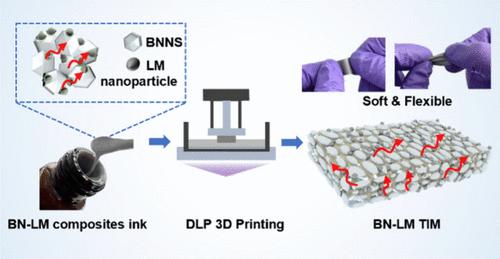用于先进电子学的可印刷氮化硼-液态金属杂化热界面材料
IF 8.2
2区 材料科学
Q1 MATERIALS SCIENCE, MULTIDISCIPLINARY
引用次数: 0
摘要
高效的热管理和机械灵活性对于现代电子设备至关重要,其中紧凑的设计和高功率密度产生大量的热量,要求材料具有高效率和优异的一致性。本文通过将二维氮化硼纳米片(BNNS)和液态金属(LM)纳米颗粒作为导热填料集成到可光固化的聚二甲基硅氧烷(PDMS)基体中,开发出具有高导热性的杂化热界面材料(TIM)。填料的界面工程促进均匀分散,形成连续的热网,在保持柔软性的同时加强传热。与传统的基于bn的3d打印TIMs相比,这种混合系统具有高导热性和超低杨氏模量(0.07 MPa),能够在复杂表面上实现卓越的一致性,并最大限度地减少热接触阻力。复合材料在反复变形下也能保持优异的电绝缘性和机械稳定性,确保长期的可靠性。在led,电池和柔性热电器件中,BN-LM TIM显着改善了散热和器件性能。这项工作提供了一种新的策略,将优化的填料相互作用与DLP 3D打印相结合,将高效的热传输与结构适应性相结合,以推进下一代柔性电子产品的热管理。本文章由计算机程序翻译,如有差异,请以英文原文为准。

Printable Boron Nitride–Liquid Metal Hybrid Thermal Interface Materials for Advanced Electronics
Efficient thermal management and mechanical flexibility are crucial for modern electronic devices, where compact designs and high power densities generate substantial heat, demanding materials with both high efficiency and excellent conformability. Herein, a hybrid thermal interface material (TIM) exhibiting high thermal conductivity is developed by integrating two-dimensional boron nitride nanosheets (BNNS) and liquid metal (LM) nanoparticles as thermally conductive fillers into a photocurable polydimethylsiloxane (PDMS) matrix. Interfacial engineering of the fillers promotes uniform dispersion and forms a continuous thermal network, enhancing heat transfer while preserving softness. Compared to conventional BN-based 3D-printable TIMs, this hybrid system offers high thermal conductivity and an ultralow Young’s modulus (0.07 MPa), enabling superior conformability on complex surfaces and minimizing thermal contact resistance. The composite also maintains excellent electrical insulation and mechanical stability under repeated deformation, ensuring long-term reliability. Demonstrated in LEDs, batteries, and flexible thermoelectric devices, the BN-LM TIM significantly improves heat dissipation and device performance. This work offers a new strategy that combines optimized filler interactions with DLP 3D printing, bridging efficient heat transport with structural adaptability to advance thermal management in next-generation flexible electronics.
求助全文
通过发布文献求助,成功后即可免费获取论文全文。
去求助
来源期刊

ACS Applied Materials & Interfaces
工程技术-材料科学:综合
CiteScore
16.00
自引率
6.30%
发文量
4978
审稿时长
1.8 months
期刊介绍:
ACS Applied Materials & Interfaces is a leading interdisciplinary journal that brings together chemists, engineers, physicists, and biologists to explore the development and utilization of newly-discovered materials and interfacial processes for specific applications. Our journal has experienced remarkable growth since its establishment in 2009, both in terms of the number of articles published and the impact of the research showcased. We are proud to foster a truly global community, with the majority of published articles originating from outside the United States, reflecting the rapid growth of applied research worldwide.
 求助内容:
求助内容: 应助结果提醒方式:
应助结果提醒方式:


